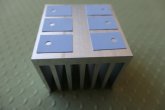Capt Bill
Sailing Options
When I eventually test the SSR dc-ac for running 120AC up to 25amps to see how hot it gets; and then use a Thermal Disc to trigger a 2nd parallel wired mechanical relay, I have this inexpensive $23 relay in mind. I have used these with different coil voltages for water pump applications, and viewed em as durable and dependable. They might be capable of being used solo, have low coil draw/ but not sure using coil to clamp contacts 24/7. I'd be more confident of durability using these for up to full 25 AMP, as a secondary kicked to ON or closed circuit when SRR get hot. I am considering the 60 amp rated dc-c SSR w Thermal Disc triggered Mechanical Relay setup as BMS control cut off of 120ac 25 amp out from my LV2424 to 120vac Circuit Breaker Box (as option to turn off inverter by turn of full all in one/ including the charger)
General Purpose Relay Rated for 25 Amps AC DPST
Normally Open Contacts, 158 mA Rated Load Current, 12 VDC Rated Load Voltage
I ordered from Allied to get faster delivery.
General Purpose Relay Rated for 25 Amps AC DPST
Normally Open Contacts, 158 mA Rated Load Current, 12 VDC Rated Load Voltage
Omron G7L-2A-BUBJ-CB DC12 General Purpose Relay With Test Button, Class B Insulation, Screw Terminal, Upper Bracket Mounting, Double Pole Single Throw Normally Open Contacts, 158 mA Rated Load Current, 12 VDC Rated Load Voltage: Electronic Relays: Am
Omron G7L-2A-BUBJ-CB DC12 General Purpose Relay With Test Button, Class B Insulation, Screw Terminal, Upper Bracket Mounting, Double Pole Single Throw Normally Open Contacts, 158 mA Rated Load Current, 12 VDC Rated Load Voltage: Electronic Relays: Amazon.com: Industrial & Scientific
www.amazon.com
I ordered from Allied to get faster delivery.
Last edited:





![wo.HeatSink [800x600].jpg](/data/attachments/14/14380-2b602433a0435baca20e6b07d2dbdf1f.jpg)
